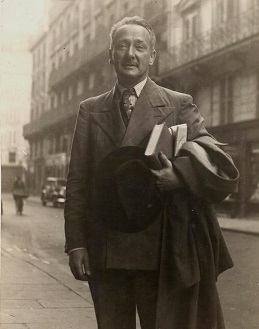Pieter van der Meer de Walcheren (1880 – 1970)
During the third decade of the twentieth century, the Catholic author Pieter van der Meer de Walcheren became one of the most prominent public intellectuals in the Netherlands. As a critic, essayist, cultural mediator and mentor, he significantly contributed to the positioning of a Catholic intellectual subculture during the interwar period.
Pieter van der Meer de Walcheren grew up in Maastricht in a liberal-bourgeois environment. As a high school student, he became acquainted with Alphons Diepenbrock. Inspired by this eminent Catholic composer and classicist, Van der de Walcheren went to study classical languages at the De Gemeente Universiteit in Amsterdam, where he soon came under the influence of Socialism and Marxism. He was attracted to De Jonge Gids (Young Guide), edited by the socialist novelist and playwright Herman Heijermans, who published some of Van der Meer’s poems and short stories, as well as his drama about class struggle, ‘De Groote Strijd’ (The Great Struggle). After graduating as a candidate at the university, Van der Meer left Amsterdam and moved to the Maison du Peuple (The House of the People) in Brussels, a dream of many a socialist. During the first decade of the twentieth century, Van der Meer de Walcheren tried to earn a living as a writer by publishing three novels, dozens of short stories, and by editing, together with Job Steynen and Albert Plasschaert, two short-term literary magazines.
His intensive association with the French Catholic writer and polemicist Léon Bloy resulted in his conversion to Catholicism, on 24 February 1911. From his hometown of Paris and inspired by the French Catholic philosopher Jacques Maritain (another convert of Bloy), Pieter van der Meer de Walcheren set up and maintained an extensive network of Dutch Catholic writers. From 1915 to 1918, he worked as a war correspondent for the Dutch newspaper De Maasbode (The River Meuse Messenger). In 1921, back in the Netherlands, Van der Meer de Walcheren became chief-editor of the Art and Letters section of the Catholic weekly magazine De Nieuwe Eeuw (The New Century). From then on, he played an important role as a public intellectual and cultural mediator. He managed to bring together a diverse group of young writers and artists and to become a liaison between Dutch, Flemish and French artists. Among them were Jan Engelman, Anton van Duinkerken, Joep Nicolas, Gerard Knuvelder, Gerard Wijdeveld, Albert Kuyle and Wies Moens.
Inspired by the British literary scholar Stefan Collini, this research aims to interpret the role of Pieter van der Meer de Walcheren as a public intellectual in and around the Catholic weekly De Nieuwe Eeuw in the years 1921-1924. The focus will be on:
- Van der Meer de Walcheren's views and activities in relation to the public debate on (Catholic) literature and art;
- His public-oriented actions in the media, in particular his editorship of the Art and Letters section of De Nieuwe Eeuw;
- The role, significance and recognition of Van der Meer de Walcheren as an internationally oriented cultural mediator and networker within the Netherlands as well as between the Netherlands and France;
- The role, significance and recognition of Van der Meer de Walcheren as a mentor for a young generation of Catholic artists and writers.
This PhD research is supervised by prof. Mathijs Sanders and prof. Hans Renders.
Jan de Ridder studied Dutch at the Katholieke Leergangen in Tilburg and at the University of Nijmegen. Mail: jan.de.ridder@hotmail.com

